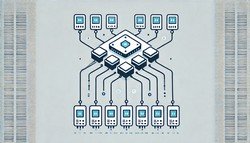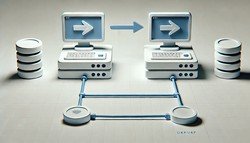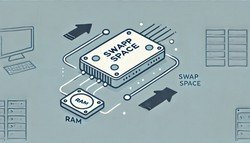Multiplexing
 (Representational Image | Source: Dall-E)
(Representational Image | Source: Dall-E)
Quick Navigation:
- Multiplexing Definition
- Multiplexing Explained Easy
- Multiplexing Origin
- Multiplexing Etymology
- Multiplexing Usage Trends
- Multiplexing Usage
- Multiplexing Examples in Context
- Multiplexing FAQ
- Multiplexing Related Words
Multiplexing Definition
Multiplexing is a technique in telecommunications and computer networking that allows multiple signals or data streams to share a single communication channel. This is achieved by segmenting the available bandwidth into multiple channels or by interleaving data streams in an organized manner. The main types of multiplexing include Time Division Multiplexing (TDM), Frequency Division Multiplexing (FDM), and Wavelength Division Multiplexing (WDM). These methods help in optimizing bandwidth usage, reducing costs, and improving efficiency in data transmission.
Multiplexing Explained Easy
Imagine you have a single road, but multiple cars need to use it. Instead of building separate roads for each car, traffic lights and lanes are used to allow different cars to take turns or share the road efficiently. Multiplexing works the same way in computers and networks—it allows multiple pieces of information to share the same communication line without colliding.
Multiplexing Origin
Multiplexing concepts can be traced back to the early days of telegraphy and telephone systems in the 19th century. It became widely used in telecommunications with the advent of radio broadcasting and fiber-optic communication, where different signals were transmitted over a single channel to maximize efficiency.
Multiplexing Etymology
The word "multiplexing" is derived from the Latin word multiplex, meaning "having many folds or layers." It reflects the technique of handling multiple signals within a single medium.
Multiplexing Usage Trends
Multiplexing has seen exponential growth with advancements in telecommunications, networking, and digital communication. It plays a critical role in modern technologies such as 5G networks, satellite communications, and optical fiber transmission. The increasing demand for faster and more efficient data transmission has made multiplexing an essential component of networking infrastructures worldwide.
Multiplexing Usage
- Formal/Technical Tagging:
- Telecommunications
- Networking
- Signal Processing - Typical Collocations:
- "Time Division Multiplexing (TDM)"
- "Frequency Division Multiplexing (FDM)"
- "Multiplexing in fiber optics"
- "Data transmission multiplexing"
Multiplexing Examples in Context
- A telephone company uses multiplexing to allow multiple phone calls to be transmitted over a single fiber-optic cable.
- Broadcasting stations use frequency division multiplexing to transmit multiple radio stations over the same frequency spectrum.
- Computer networks use multiplexing techniques to efficiently share bandwidth among different users and devices.
Multiplexing FAQ
- What is multiplexing?
Multiplexing is a method that allows multiple signals or data streams to be transmitted over a single communication channel. - What are the types of multiplexing?
The main types include Time Division Multiplexing (TDM), Frequency Division Multiplexing (FDM), and Wavelength Division Multiplexing (WDM). - Why is multiplexing important?
It maximizes the utilization of available bandwidth, reduces transmission costs, and improves network efficiency. - Where is multiplexing used?
It is used in telecommunications, broadcasting, computer networking, and satellite communications. - How does Time Division Multiplexing work?
TDM assigns time slots to different signals, ensuring each gets a turn to transmit data over a shared channel. - How does Frequency Division Multiplexing work?
FDM assigns different frequency bands to different signals, allowing them to coexist on a single channel. - What is Wavelength Division Multiplexing?
WDM is a technique used in fiber-optic communication that allows multiple optical signals to be transmitted using different wavelengths. - What are the advantages of multiplexing?
It optimizes bandwidth, reduces interference, and enhances data transmission speed. - Can multiplexing improve internet speed?
Yes, by efficiently managing bandwidth and data transmission, it improves network performance. - Is multiplexing used in 5G technology?
Yes, advanced multiplexing techniques are crucial for high-speed and low-latency communication in 5G networks.
Multiplexing Related Words
- Categories/Topics:
- Telecommunications
- Networking
- Digital Signal Processing
Did you know?
One of the first practical uses of multiplexing was in telegraphy, where a single telegraph line could carry multiple messages using time-sharing techniques. Today, multiplexing is used in fiber-optic cables that transmit terabytes of data per second, enabling high-speed internet across the world.
Authors | Arjun Vishnu | @ArjunAndVishnu

PicDictionary.com is an online dictionary in pictures. If you have questions or suggestions, please reach out to us on WhatsApp or Twitter.
I am Vishnu. I like AI, Linux, Single Board Computers, and Cloud Computing. I create the web & video content, and I also write for popular websites.
My younger brother, Arjun handles image & video editing. Together, we run a YouTube Channel that's focused on reviewing gadgets and explaining technology.
















Comments (0)
Comments powered by CComment